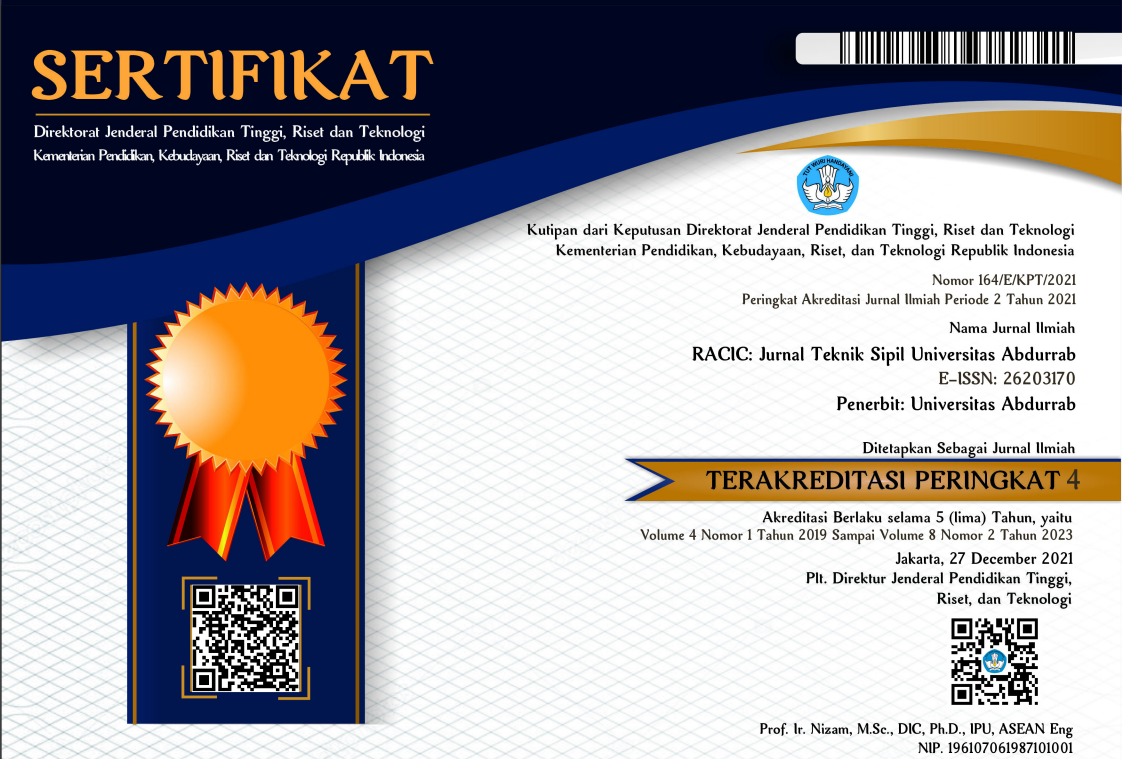OPTIMASI PROYEK PEMBANGUNAN GEDUNG WORKSHOP TEKNIK MESIN UPN VETERAN JAWA TIMUR DENGAN METODE TIME COST TRADE OFF
DOI:
https://doi.org/10.36341/racic.v9i1.4162Keywords:
Pengoptimalan, Akselerasi, Project Crashing, Time Cost Trade OffAbstract
Projects are temporary initiatives with limited time, resources, and goals. Due to time and financial constraints, project planning is crucial, with project management being a key factor in its success. Consistency in the quality, cost, and time of a construction project requires the selection of effective construction methods. The purpose of this study is find out the construction costs by adding working hours using the TCTO method, knowing the acceleration of construction time by adding working hours using the TCTO method. These methods impact the construction duration, material usage, equipment, and labor. In the case of the Workshop Building for Mechanical Engineering at UPN Veteran East Java, issues arose during boredpile work due to marshy soil, limiting the installation to only 2 points per day, resulting in a 9-week delay from week 11 to week 20. Additionally, challenges included the time-consuming disposal of boredpile soil and equipment damage, requiring weekly repairs lasting approximately 4 hours. Therefore, acceleration is needed to address these delays, which can be achieved through the Project Crashing approach using the Time Cost Trade Off (TCTO) method.
Downloads
References
R. Respati, A. Sugianto, and W. Bagus Santoso, “Kajian Percepatan Proyek dengan Metode Time Cost Trade Off pada Proyek Pembangunan Jalan Tol Balikpapan-Samarinda Seksi V,†J. Ilm. Tek. Sipil TRANSUKMA, vol. 3, no. 2, pp. 142–153, 2021, doi: 10.36277/transukma.v3i2.81.
C. Reynaldi and A. Sutandi, “Analisis Percepatan Proyek Menggunakan Metode Time Cost Trade Off - Studi Kasus Apartemen Collins Boulevard,†JMTS J. Mitra Tek. Sipil, vol. 5, no. 2, pp. 497–506, 2022, doi: 10.24912/jmts.v5i2.16450.
N. Saputra, E. Handayani, and A. Dwiretnani, “Analisa Penjadwalan Proyek dengan Metode Critical Path Method (CPM) Studi Kasus Pembangunan Gedung Rawat Inap RSUD Abdul Manap Kota Jambi,†J. Talent. Sipil, vol. 4, no. 1, p. 44, 2021, doi: 10.33087/talentasipil.v4i1.48.
A. I. Afrizal, “TIME COST TRADE OFF ANALISYS UNTUK PENGOPTIMALAN WAKTU DAN BIAYA PROYEK (STUDI KASUS : PEMBANGUNAN UPT PUSKESMAS KARANGPUCUNG),†2018.
Onibala, E. C., Inkiriwang, R. L., & Sibi, M. (2018). Metode Pelaksanaan Pekerjaan Konstruksi Dalam Proyek Pembangunan Sekolah Smk Santa Fimilia Kota Tomohon. Jurnal Sipil Statik, 6(11), 927–940
S. Singh, “Optimizing time–cost trade-off decisions in an interval transportation problem with multiple shipment options,†Eng. Optim., vol. 55, no. 1, pp. 53–70, 2023.
N. Sembiring, Buku Ajar Manajemen Proyek. 2014. [Online]. Available: http://repository.usu.ac.id/bitstream/handle/123456789/71890/Fulltext.pdf?sequence=1&isAllowed=y
Awaluddin, L. O. M. I. (2019). Analisa Percepatan Waktu Dengan Menggunakan Metode Trade Cost Trade Off (Tcto) Pada Proyek Apartemen Puncak Merr Surabaya.
S. Rahayu, Nurwan, and D. Wungguli, “Analisis Critical Path Method dan Time Cost Trade Off dalam Optimasi Waktu dan Biaya Pengerjaan Proyek Pembangunan Rumah Sakit,†J. Ilm. Mat. Dan Terap., vol. 19, no. 2, pp. 227–242, 2022, doi: 10.22487/2540766x.2022.v19.i2.16176.
R. Pratiwi, M. Mustakim, and C. Annisa Forester Bangabua, “Optimalisasi Waktu dan Biaya Menggunakan Time Cost Trade Off Method (TCTO) dan Precedence Diagram Method (PDM) pada Pembangunan Drainase Jalan Tol KM. 35 Balikpapan-Samarinda,†J. Ilm. Tek. Sipil TRANSUKMA, vol. 3, no. 1, pp. 1–9, 2020, doi: 10.36277/transukma.v3i1.65.
Downloads
Published
Issue
Section
License
1. Copyright of all journal manuscripts is held by the RACIC : Rab Construction Research
2. Formal legal provisions to access digital articles of electronic journal are subject to the provision of the Creative Commons Attribution-ShareAlike license (CC BY-NC-SA), which means that RACIC : Rab Construction Research is rightful to keep, transfer media/format, manage in the form of databases, maintain, and publish articles.
3. Published manuscripts both printed and electronic are open access for educational, research, and library purposes. Additionally, the editorial board is not responsible for any violations of copyright law.
licensed under a Creative Commons Attribution-ShareAlike 4.0 International License.





